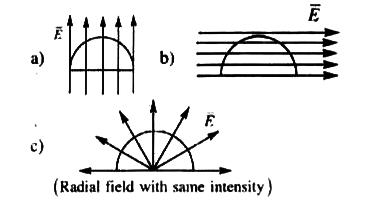A uniform electric field exists in space. Find the flux of this field through a cylindrical surface with the axis parallel to the field.
To find the electric flux through a cylindrical surface with its axis parallel to a uniform electric field, we can follow these steps:
1. Understand the Setup:
- We have a uniform electric field (E) directed along the positive x-axis.
- A cylindrical surface is placed such that its axis is parallel to the electric field.
2. Identify the Surface Area:
- The cylindrical surface has a curved surface area and two circular ends (top and bottom). However, since the axis of the cylinder is parallel to the electric field, the electric field lines will pass through the ends of the cylinder but not through the curved surface.
3. Determine the Area Vector:
- The area vector (dA) for the curved surface of the cylinder is perpendicular to the surface and points radially outward.
- For the ends of the cylinder, the area vectors point along the axis of the cylinder, which is parallel to the electric field.
4. Calculate the Flux:
- The electric flux (Φ) through a surface is given by the formula:
Φ=∫→E⋅d→A
- For the curved surface of the cylinder, the angle (θ) between the electric field (E) and the area vector (dA) is 90 degrees. Therefore, the flux through the curved surface is:
Φcurved=E⋅A⋅cos(90∘)=E⋅A⋅0=0
- For the circular ends of the cylinder, the area vectors are parallel to the electric field, but since we are only interested in the flux through the cylindrical surface (which is the curved part), we conclude:
Φends=0(as we are not considering the ends)
5. Final Result:
- The total electric flux through the cylindrical surface (curved part) is:
Φ=0
Conclusion:
The electric flux through the cylindrical surface with its axis parallel to the electric field is zero.
---
- We have a uniform electric field (E) directed along the positive x-axis.
- A cylindrical surface is placed such that its axis is parallel to the electric field.
- The cylindrical surface has a curved surface area and two circular ends (top and bottom). However, since the axis of the cylinder is parallel to the electric field, the electric field lines will pass through the ends of the cylinder but not through the curved surface.
- The area vector (dA) for the curved surface of the cylinder is perpendicular to the surface and points radially outward.
- For the ends of the cylinder, the area vectors point along the axis of the cylinder, which is parallel to the electric field.
- The electric flux (Φ) through a surface is given by the formula:
Φ=∫→E⋅d→A
- For the curved surface of the cylinder, the angle (θ) between the electric field (E) and the area vector (dA) is 90 degrees. Therefore, the flux through the curved surface is:
Φcurved=E⋅A⋅cos(90∘)=E⋅A⋅0=0
- For the circular ends of the cylinder, the area vectors are parallel to the electric field, but since we are only interested in the flux through the cylindrical surface (which is the curved part), we conclude:
Φends=0(as we are not considering the ends)
- The total electric flux through the cylindrical surface (curved part) is:
Φ=0
The electric flux through the cylindrical surface with its axis parallel to the electric field is zero.
Topper's Solved these Questions
- GAUSS LAWBOOK - HC VERMA ENGLISHCHAPTER - GAUSS LAWEXERCISE - Work Out Exaples
8 Videos
- GAUSS LAWBOOK - HC VERMA ENGLISHCHAPTER - GAUSS LAWEXERCISE - Objective 1
6 Videos
- ELECTROMAGNETIC WAVESBOOK - HC VERMA ENGLISHCHAPTER - ELECTROMAGNETIC WAVESEXERCISE - Exercise
8 Videos
- GEOMETRICAL OPTICSBOOK - HC VERMA ENGLISHCHAPTER - GEOMETRICAL OPTICSEXERCISE - Question For short Answer
18 Videos
Similar Questions
If the flux of the electric field through a closed surface is zero,
View SolutionGiven a uniform electric field E=2×103ˆiN/C find the flux of this field through a square of side 20cm, whose plane is parallel to the y-z plane. What would be the flux through the same square, if the plane makes an angle of 30∘ with the x axis?
View SolutionGiven a uniform electric field →E=5×103ˆiN/C, find the flux of this field through a square of 10cm on a side whose plane is parallel to the y - z plane. What would be the flux through the same square if the plane makes a 30∘ angle with the x-axis?
View SolutionIn the uniform electric field shown in figure, find

View SolutionGiven a uniform electric field →E=4×103ˆiN/C. Find the flux of this field through a square of side 5cm on a side whose plane is parallel to the y-z plane. What would be the flux through the same square, if the plane makes a 30∘ angle of with the x-axis?
View SolutionThe flux of electric field through the circular region of radius r as shown in the figure is
_PHY_E05_291_Q01.png)
View SolutionA Gaussian surface in the cylinder of cross-section πa2 and length L is immersed in a uniform electric field E with the cylinder axis parallel to the field. The flux ϕ of the electric field through the closed surface is
View SolutionA hemispherical body of radius R is placed in a uniform electric field E. What is the flux linked with the curved surface if, the field is (a) parallel to the base, (b) perpendicular to the base.
View SolutionA hemispherical body of radius R is placed in a uniform electric field E. What is the flux linked with the curved surface if, the field is (a) parallel to the base, (b) perpendicular to the base.
View SolutionFind the flux due to the electric field through the curved surface (R is radius of curvature)

View Solution
